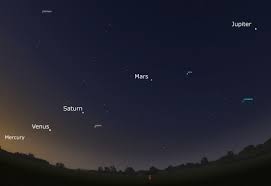Posted on: Thursday January 21, 2016
This has been a busy week for solar system news. For early risers, you can see all five of the naked-eye planets at the same time before sunrise. This week also saw the announcement of some new research suggesting there may be an undiscovered planet out there, way out past Neptune.

We’ll start with the easy one. There are five planets in our sky that can be easily seen with the unaided (or “naked”) eye – without a telescope or binoculars, but most of the time only two or three are visible at any given time. For the next several weeks, though, you can see all five at once. Just wait for a clear morning, get up early, and head to a location where you have a clear horizon to the south and southeast. You’ll want to observe about 45 minutes before the sun comes up, while the sky is still dark enough.
The first thing you will notice is Venus, shining brightly in the southeast. Venus has been visible before dawn for months now, and since it is the brightest object in the sky after the Sun and Moon, a lot of people have noticed it in the southeast as they get up for work or school before the sun rises. The next-brightest object in the sky is the planet Jupiter, which was close to Venus last fall but has since migrated across the sky towards the southwest. That’s two planets.
In between Venus on your left and Jupiter on your right, there are a bunch of bright-ish objects. About halfway between the two, and higher up in the south, is a fairly bright object that you might notice has a slightly red-orange hue. That’s Mars, planet number three on our list of targets.
Between Mars and Venus is number four: the ringed planet Saturn. Saturn’s rings aren’t visible without a telescope, but it is the most distant planet you can see with your unaided eye, at over 1.5 billion kilometres away from Earth.
Number five on our list is the most difficult one. The planet Mercury is tough to see, because it is so close to the sun we can only see it in the brightening twilight sky. Mercury appears to the lower left of Venus and very close to the horizon. As the days pass, it will rise higher in the sky as it orbits the sun, and then drop back down below the horizon again. You probably will only have a couple of weeks to see Mercury unless we have very clear skies and you have very good eyes, since the lower it gets the harder it will be to find. Binoculars can help you track it down in the twilight.
If you want to add a sixth planet, just look around: the Earth is a planet, too. And the moon will move through the seen in the first week of February, along the path from Jupiter to Mercury in our sky. It’s a great time to watch the morning sky!
Now, the other “planet” announcement this week, which suggests a new planet has been “discovered”. It hasn’t – at least, not yet. As usual, the social media sites blow everything out of proportion. Some new research suggests that some of the odd observations of objects at the very edge of the solar system could be explained if there were an undiscovered planet orbiting the sun at an incredible distance, far beyond Neptune. The trouble is, we don’t have a lot of data on what’s out there, so there are many possible explanations for the strange stuff we’re seeing. Definitely a story worth following, but don’t change the textbooks just yet.





